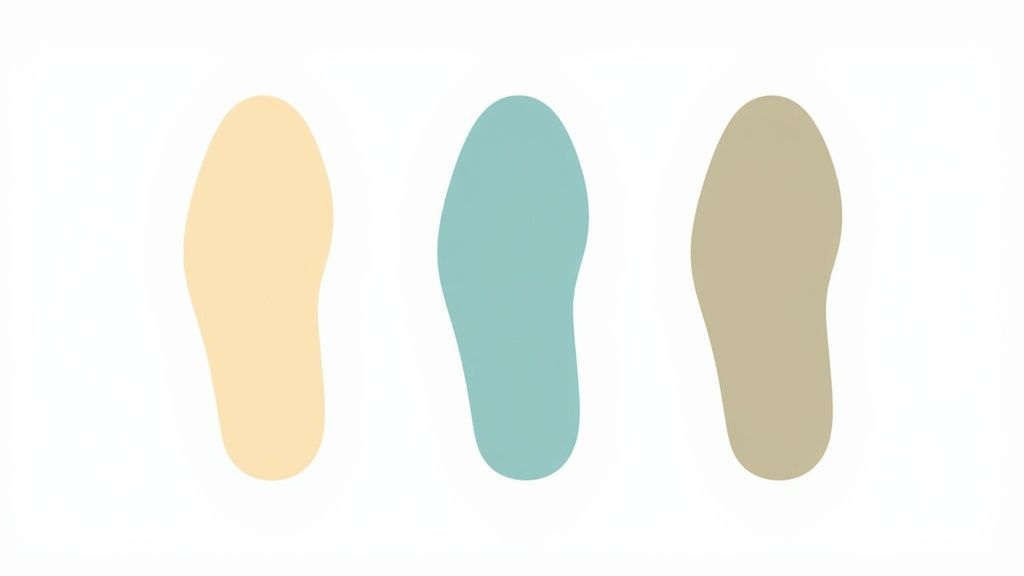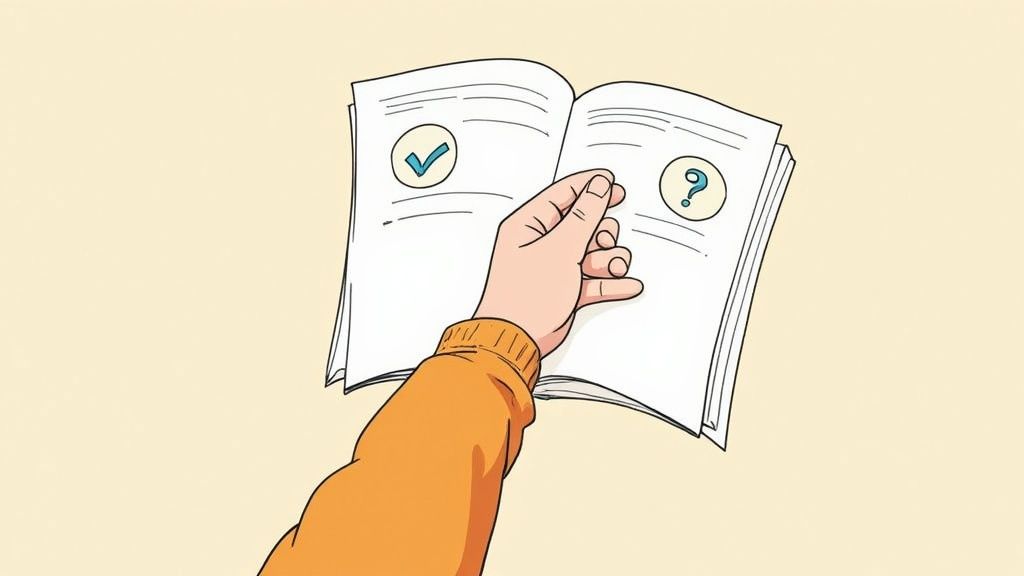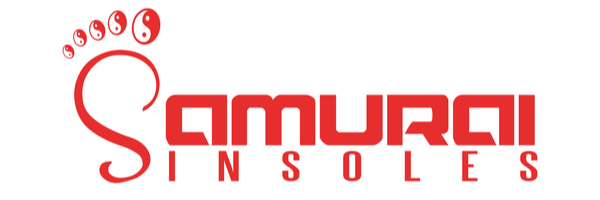Let's get straight to the point: your heel hurts, and you're looking for a way to make it stop. I've been there, and I can tell you that finding the right insoles for heel pain can be a game-changer. They're more than just a piece of foam; they act as a custom support system right inside your shoe, delivering targeted relief and helping realign your foot.
Your First Step Away From Heel Pain

When your heel is throbbing, every step feels like a chore. The main job of a quality insole is to take the immense pressure your body puts on your feet and spread it out. Instead of all that force pounding down on one sore spot, a good insole distributes it evenly across the entire sole of your foot.
Think of this guide as your roadmap. We’ll cut through the noise and show you exactly how to find insoles that bring real relief, starting now.
How Insoles Actually Work
A great insole does more than just provide a soft landing. It gets to the root of the problem by correcting biomechanical imbalances that cause the pain in the first place. Conditions like plantar fasciitis are often tied to how your foot moves, especially overpronation (when your foot rolls too far inward as you walk).
Here's how a well-designed insole tackles this:
- Targeted Cushioning: It places extra padding right where you need it most—under the heel—to soften the impact of each step.
- Arch Support: It props up your arch to keep it from collapsing, which takes a huge amount of strain off the plantar fascia ligament.
- Heel Stabilization: A deep heel cup cradles the fatty pad under your heel, locking it in place and boosting your body's own natural shock absorption.
An insole provides a stable base for your foot, just like a solid foundation supports a house. When your feet are properly supported, your ankles, knees, and hips stay better aligned, stopping the chain reaction of pain before it starts.
You're Not Alone in This
If you're searching for foot relief, you're in good company. More and more people are realizing that taking care of their feet is crucial for overall well-being. The market for products like these is booming.
In fact, the orthopedic insole market was valued at USD 3.2 billion in 2025 and is expected to more than double by 2035. This isn't just a trend; it's driven by a growing understanding of how proper foot mechanics can solve problems like chronic heel pain.
While insoles are a fantastic tool, it can also be helpful to look at other treatments. For a more comprehensive approach, some people find relief by learning how chiropractic can rescue your foot from pain's grip as a complementary therapy.
Sorting Through the Different Types of Insoles

Have you ever stood in the foot care aisle at the pharmacy, completely stumped? You're staring at a wall of insoles—some are squishy gel, others are firm and plastic-looking—and they all claim to be the magic bullet for your heel pain. It's easy to feel lost.
The truth is, not all insoles are the same. What works for your neighbor might do nothing for you because your feet, your daily activities, and the actual source of your pain are entirely unique. Let's cut through the confusion and figure out what you're really looking at.
Cushioning vs. Support: What's the Real Difference?
The first thing you need to understand is the massive difference between insoles that cushion and insoles that support. They are not interchangeable.
A super-soft gel insole might feel fantastic at first, especially if you stand on hard floors all day. It’s like adding a plush pillow to your shoe. It absorbs shock but does very little to fix any underlying mechanical problems in your foot.
Then you have firmer, more structured insoles, which are often called orthotics. These are built to control how your foot moves. If your heel pain is caused by something like overpronation (when your foot collapses inward too much), this is the kind of insole you need. It provides the stability to realign your foot and take the stress off your plantar fascia.
Key Takeaway: Think of it this way: cushioning is like adding a pillow under your foot, while support is like building a proper foundation. For lasting heel pain relief, you almost always need the foundation, not just the pillow.
The demand for real support is booming. The foot orthotic insoles market was valued at USD 4.83 billion in 2024 and is expected to climb to USD 8.23 billion by 2033. It's clear more people are realizing that proper foot support is a cornerstone of overall health. You can see detailed projections on the foot orthotics market to understand these trends better.
A Quick Guide to Insole Materials
The material an insole is made from is everything—it dictates how it feels, what it does, and how long it will last. Here's a simple comparison to help you tell them apart.
Comparing Insole Types for Heel Pain Relief
This table breaks down the most common insole types so you can see how their function, ideal use, and materials differ. It’s a great starting point for narrowing down your options.
| Insole Type | Primary Function | Best For | Common Materials | Price Range |
|---|---|---|---|---|
| Gel Insoles | Shock absorption and light cushioning | Standing for long periods, general foot fatigue | Silicone, Thermoplastic Gel | $10 - $25 |
| Foam Insoles | Cushioning and pressure relief | Athletic activities, everyday comfort | Memory Foam, Polyurethane | $15 - $40 |
| Cork Insoles | Firm, moldable support and stability | Correcting alignment, custom-like fit over time | Natural Cork, EVA blends | $30 - $60 |
| Rigid Orthotics | Motion control and structural support | Overpronation, plantar fasciitis, high arches | Plastic, Carbon Fiber | $40 - $80+ |
As you can see, a runner with plantar fasciitis needs the serious motion control of a rigid or semi-rigid orthotic. On the other hand, a retail worker with generally achy feet might find all the relief they need from a high-quality foam or gel insole.
Ultimately, the goal is to match the insole's design to your specific pain and lifestyle. For a much closer look at what to prioritize, check out our complete guide to the best insoles for heel pain, where we break down the most important features in detail.
How to Find the Right Insole for Your Foot

Choosing the right insole shouldn't feel like a lottery. With a sea of options out there, it’s easy to get overwhelmed. But finding real relief for your heel pain is about making a smart, personalized choice, not just grabbing the first thing you see on the shelf.
A little self-assessment goes a long way. This isn't about guessing; it's about understanding your unique feet and how you live your life. An insole that’s perfect for a marathon runner will be totally wrong for a warehouse worker spending eight hours on concrete.
Let’s walk through how to match an insole to what you actually need.
Start With Your Arch Type
The foundation of a good fit is, well, your foundation—your foot’s arch. How your arch is shaped dictates how your body weight is distributed with every single step. Get it wrong, and you can create biomechanical problems that put a ton of stress right on your heel.
Thankfully, you don't need a fancy lab to figure this out. A simple at-home method called the "wet test" will give you a surprisingly good read on your arch type.
Here’s all you have to do:
- Pour a thin layer of water into a shallow pan.
- Step into the water with one bare foot, making sure the entire sole gets wet.
- Carefully step onto a piece of cardboard or even a dark towel—anything that will show a clear footprint.
- Step off and take a look at the imprint you left behind.
This simple test helps you see if you have one of the three main arch types, each of which needs a different kind of support.
Pro Tip: Your arch type is a huge piece of the puzzle. If you have flat feet, you need firm support to keep your foot from collapsing inward. On the flip side, a high arch needs more cushioning to absorb shock. Knowing this simple fact helps you immediately filter out dozens of insoles that just won't work for you.
More and more people are catching on to this. In fact, the global foot insoles market is expected to grow by about USD 2.2 billion between 2025 and 2029. This boom is happening because people are getting more active and finally understanding that the right orthotics can prevent and treat nagging heel pain. You can read more about the growth of the foot insoles market and its drivers if you’re curious about the industry trends.
Match the Insole to Your Life
Next, think about your day-to-day grind. Are you constantly on your feet, or are you a "weekend warrior" who sits at a desk all week? The intensity and type of your activities make a huge difference when choosing insoles for heel pain.
-
High-Impact Activities: If you’re a runner or play sports like basketball, you need an insole that offers serious shock absorption and firm, stabilizing support. Look for durable materials that won’t flatten out after a few hard workouts.
-
Standing All Day: For those in retail, healthcare, or any job that involves long hours of standing and walking, the key is a balance of cushioning and structure. An insole with a deep heel cup and solid arch support will be your best friend, preventing that end-of-day foot fatigue and pain.
-
Casual, Everyday Use: Just looking for better comfort while walking and running errands? A flexible insole with moderate support is usually all you need to ease common heel pain and make your daily shoes feel a whole lot better.
When to See a Professional
While you can get pretty far on your own, sometimes you just need an expert. If you’ve already tried a few over-the-counter insoles and aren't getting relief, or if your heel pain is severe and just won't go away, it's time to book an appointment with a podiatrist.
A podiatrist can perform a full biomechanical analysis to pinpoint the exact cause of your pain. From there, they can prescribe custom orthotics that are molded specifically for your feet. It's the most precise solution you can get, offering tailored support to correct even complex foot issues.
Fitting and Breaking In Your New Insoles

So, you've done your homework and picked out what you hope are the perfect insoles for heel pain. That's a huge step! But even the best orthotic on the market won't do you any good if it doesn't fit properly in your shoe. A bad fit can undo all the potential benefits, sometimes even creating new sore spots.
Getting this right involves two key phases. First, you have to get the insole sized correctly for your specific shoe. Second, you need to give your feet time to get used to the new support. Let’s get into how to do both.
Trimming for a Perfect Fit
Most full-length insoles you'll buy are "trim-to-fit." This means they're made in general sizes and you need to customize them at home. It sounds a bit nerve-wracking, but it’s actually pretty straightforward.
The absolute best way to do this is to use the original liner that came with your shoe as a template. Don't eyeball it or try tracing the inside of your shoe. Just pull out the factory liner.
- Lay the factory liner directly on top of your new insole. Make sure you line them up perfectly at the heel.
- Grab a pen and trace the outline of the old liner onto the toe area of your new one.
- Using a sharp pair of scissors, just cut along the line you drew.
My best piece of advice: Be conservative with your first cut. You can always trim off a little more, but you can’t put it back. After that first trim, pop the insole into your shoe. If it buckles or has a wrinkle, pull it out and shave off a tiny bit more. Keep doing this until it lies perfectly flat and smooth from heel to toe.
Of course, a perfect insole can't fix a shoe that's the wrong size to begin with. Making sure your shoes fit well, especially in terms of width, is fundamental. If you're not sure about your shoe sizing, this is a fantastic resource: an ultimate guide to wide-width shoes for maximum comfort.
The Crucial Break-In Period
Once the insole fits inside the shoe, it's so tempting to just leave it in and go about your day. I get it, but you have to resist that urge. Your feet, muscles, and ligaments have adapted to your old (and probably unsupportive) setup. Suddenly adding firm arch support can be a real shock to the system.
You need to ease into it. A slow break-in period lets your body adjust without getting overly sore. It’s a lot like starting a new workout program—you don't go from the couch to running a marathon overnight.
Here’s a simple schedule I recommend to my clients:
- Days 1-2: Wear the new insoles for just 1-2 hours a day.
- Days 3-4: Bump that up to about 3-4 hours.
- Days 5-7: Try wearing them for most of the day. If you feel any real pain or major discomfort, take them out.
After about a week or two, you should be able to wear your insoles all day comfortably. It’s totally normal to feel a bit of "arch awareness" or even some slight tenderness at first. However, sharp or escalating pain is a sign that something's not right. It could be a poor fit or the wrong type of support for your foot, and you should stop wearing them.
Keeping Your Insoles Effective for Longer
You’ve invested in a quality pair of insoles for heel pain, which is a brilliant move for your feet. But it's not quite a "set it and forget it" deal. To get that lasting relief you're after, your insoles need a little bit of care. Think of them like any other important piece of equipment—a little maintenance goes a long way in extending their life and effectiveness.
Keeping them clean does more than just stop them from getting stinky. It helps preserve the foam, gel, or cork materials, ensuring they keep giving your feet the solid support they need to combat heel pain.
Simple Cleaning and Maintenance Tips
Here’s the golden rule, and it's non-negotiable: never, ever put your insoles in a washing machine or dryer. I've seen it happen, and it's a fast track to ruin. The high heat and aggressive tumbling will absolutely destroy the adhesives and warp the supportive structure, rendering them useless.
Instead, a quick hand-wash every few weeks (or whenever they need it) is all it takes.
- Air Them Out Daily: Get into the habit of pulling your insoles out of your shoes when you get home. This is probably the single best thing you can do to prevent odor. It lets both the insoles and your shoes breathe and dry out completely.
- Give Them a Quick Wipe: For most modern foam or gel insoles, all you really need is a cloth, some warm water, and a drop of mild soap. A gentle wipe-down is usually enough to get them clean.
- Spot Clean Tough Stains: If you've got a stubborn spot, an old soft-bristled toothbrush is your best friend. You can gently scrub the area without tearing up the material.
- Always Air Dry: Once they're clean, just lay your insoles flat somewhere with good air circulation. Keep them away from direct heat sources like a vent or a radiator, and out of direct sunlight. Intense heat can make them shrink or lose their shape.
This simple routine honestly makes a huge difference. You'll get so much more life out of your insoles and ensure you're getting your money's worth.
Recognizing When It's Time for a Replacement
Even the best-made insoles won't last forever. The materials that cushion your feet and support your arch take a beating with every single step. After a while, they compress and break down. Wearing worn-out insoles can be just as bad as wearing no insoles at all, because they've lost the ability to do their job.
It's crucial to replace your insoles when they show signs of wear. Continuing to use a flattened, worn-out insole can allow your old foot pain symptoms to creep back in, undoing all your progress.
Keep an eye out for these tell-tale signs that it's time for a new pair:
- Visible Cracks or Tears: Any obvious damage to the foam or the supportive plastic shell is a major red flag.
- Flattened Cushioning: Press down on the insole. If it feels compressed and doesn't spring back, the cushioning is gone.
- Fading Logos: If the logo under your heel or the ball of your foot is worn away, it's a good sign of heavy use and wear.
- The Pain Returns: This is the most important clue. If that familiar heel pain starts making a comeback, your insoles are almost certainly the culprit.
Of course, insole care is just one part of the puzzle. To really stay ahead of heel pain, it's smart to combine the support from your orthotics with other therapies. We've put together a guide on some simple but effective plantar fasciitis massage techniques you can do at home. Taking this kind of proactive approach is the key to staying comfortable on your feet for the long haul.
Common Questions About Insoles and Heel Pain
Once you get the basics down, the real-world questions always start to pop up. It’s one thing to understand why insoles can help your heel pain, but it's another thing entirely to use them every single day. Let's tackle some of the most common concerns I hear, so you can feel confident on your path to pain-free feet.
Can Insoles Make My Heel Pain Worse at First?
It's actually pretty common to feel some new or different sensations when you first start wearing supportive insoles. Don't panic—this is usually just the "break-in" period. Your feet are adjusting to a new, healthier alignment, which can feel a bit strange after they’ve been out of whack for a while.
Think of it as your arches waking up. This initial awareness or even mild soreness should disappear within one to two weeks as you ease into wearing them. Start with just an hour or two a day and build from there. But here's the crucial part: if you feel any sharp, shooting, or intense pain, that's a major red flag. That’s your body telling you the insole isn't the right fit, and you should stop wearing it immediately.
Expert Tip: A little "arch awareness" as your foot adapts is normal. Sharp pain is not. Always listen to what your body is telling you.
How Often Should I Replace My Insoles?
This is a fantastic question, and the honest answer is: it depends. The lifespan of an insole really comes down to three key factors: the materials it's made from, how active you are, and your body weight. A construction worker who's on their feet for ten hours a day will need replacements far sooner than someone who works at a desk.
Still, you need a starting point. Here are some general guidelines:
- Softer Over-the-Counter Insoles: For most foam or gel-based insoles, you're looking at a lifespan of about 6 to 12 months.
- Firmer, Semi-Rigid Orthotics: Higher-quality, more durable orthotics like ours are built to last and can serve you well for several years if cared for.
The best way to know for sure is to look for signs of wear and tear. Are there visible cracks? Does the cushioning feel flat and lifeless? Or, most importantly, are your old heel pain symptoms starting to creep back in? If you answer yes to any of these, it's time for a new pair.
For a deeper look into your recovery timeline and treatment options, check out our guide on how to treat plantar fasciitis effectively.
Do I Need Special Shoes to Use Insoles?
You don't need "special" shoes, but you do need the right kind of shoes. The best shoes for insoles are ones that have their own removable factory footbeds. This is the key.
Almost all good-quality athletic shoes, and many casual shoes, have a thin liner that you can easily pull out. You'll simply take that out and slide your new supportive insole in its place. This is what gives you a perfect fit without making the shoe feel tight or cramped.
Whatever you do, never stack your new insole on top of the one that came with the shoe. It's a surprisingly common mistake that can squish your toes, change how the insole works, and even create brand new pressure points.
Can I Move One Pair of Insoles Between Different Shoes?
Absolutely! In fact, it's a smart way to get consistent support across your daily routine. Moving a single pair of insoles between similar shoes—say, from your work sneakers to your weekend sneakers—works perfectly fine.
The only catch is that an insole designed for a roomy running shoe probably won't fit well inside a slim dress shoe. For total convenience, many people find it's worth investing in a couple of pairs of their favorite insoles to keep in the shoes they wear most. That way, the support is always there when you need it.
Ready to find the support your feet have been begging for? At Samurai Insoles, we’ve engineered insoles to target the root cause of heel pain, providing the stability and comfort you need to get back on your feet. Experience the difference for yourself. Find your perfect pair of Samurai Insoles today!



